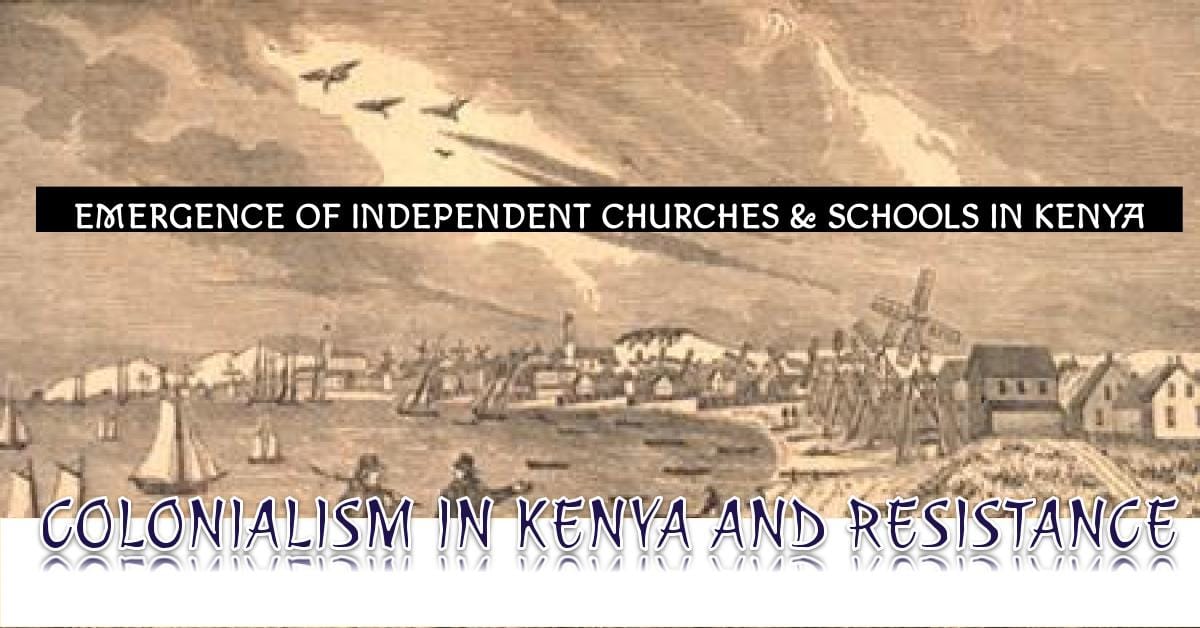📚✝️ EMERGENCE OF INDEPENDENT CHURCHES & SCHOOLS IN KENYA 🇰🇪
African Resistance to Colonial Interference in Education and Religion
Historical Context
This movement represented African protest against European interference with traditional African economic and political organization during colonial rule, combining religious, educational, and political resistance.
🛑 Primary Reasons for Emergence
Cultural Preservation
Africans wanted to retain cultural values while converting to Christianity, opposing missionary condemnation of customs like polygamy, traditional brews, and female circumcision.
Educational Reform
Rejection of the limited “3Rs” (Reading, Writing, Arithmetic) curriculum that prepared Africans only for low positions in government or European farms/homes.
Colonial Resistance
Protest against oppressive colonial policies including taxation, kipande system, forced labor, and racial discrimination.
African Leadership
Desire for self-governance in religious matters rather than European missionary control, exemplified by figures like John Owalo and Elijah Masinde.
Religious Interpretation
Dissatisfaction with missionary interpretation of scriptures and restrictions on African worship styles (dancing, drumming).
⚡ Defining Characteristics
Accommodated African cultural values in worship and education
Valued Christianity and Western education but rejected Westernization
Complete African leadership in churches and schools
Close collaboration with African political associations like KCA
NYANZA REGION MOVEMENT
John Owalo & Nomiya Luo Church
Background: Former member of Roman Catholic, Church of Scotland Mission (CSM), and CMS before founding independent church
1907: Claimed divine call to start his own church, dismissed as “lunatic” by CMS at Maseno
1910: Founded Nomiya Luo Church – Kenya’s first independent church, with permission from Nyanza PC John Ainsworth
Unique Aspect: Proclaimed himself as prophet equating to Jesus
Other Significant Nyanza Churches:
| Church Name | Founder | Year | Unique Features | Origin |
|---|---|---|---|---|
| Dini ya Roho (Holy Spirit Church) | Luhya members | 1927 | Speaking in tongues, baptism by ‘holy spirit’ | Breakaway from Friends African Mission |
| Joroho Church | Alfayo Odongo Mango | 1932 | Similar to Dini ya Roho | Luo community |
| Christian Universal Evangelical Union (Now Christian Evangelical Church) | Ismael Noo | 1938 | Emphasized sexual relations among saved members | Anglican breakaway at Nyabondo convention |
CENTRAL KENYA MOVEMENT
Context
Central Kenya experienced intense white settlement and missionary activity. Mission schools focused only on basic literacy/numeracy while condemning African practices (polygamy, traditional brews, female circumcision).
Key Developments Timeline:
First Independent School
Established at Gaithieko, Kiambu on land donated by elder Mukunga wa Njehu
Githunguri School
Second major independent school established and registered
Female Circumcision Crisis
After mission schools expelled children of circumcision supporters, schools established at Gituamba (land donated by Kagere Gatundu and Gathai Gachohi) and later Mariira, Kahiti, Gakarara
KISA Formation
Kikuyu Independent Schools Association established to coordinate schools with leaders: Daudi Maina Kiragu, Musa Muriithi, Hezekiah Gachui, Peter Gathecha, Johana Njoroge
By 1935: 34 schools with 2,518 pupils
African Orthodox Church
Archbishop William Alexander from South Africa established seminary at Gituamba, ordained African ministers: Daudi Maina Kiragu, Philip Kiande, Harrison Gachukia Kimanga
Pentecostal Breakaway
Daudi Maina Kiragu and Harrison Gachukia Kimanga formed African Independent Pentecostal Church
Githunguri College
Kenya Teachers Training College established at Githunguri under Mbiyu Koinange to train teachers for independent schools
State of Emergency
All independent schools and churches banned including KISA (168 schools, 60,000 pupils) and KKEA
Kikuyu Independent Schools Association (KISA)
Affiliation: Independent Pentecostal Church
Regions: Murang’a, Nyeri, Embu, Rift Valley
Leadership: Daudi Maina Kiragu, Musa Muriithi, Hezekiah Gachui
1952 Status: 168 schools, 60,000 pupils
Church: Named Independent Pentecostal Church in 1938
Kikuyu Karinga Educational Association (KKEA)
Meaning: “Karinga” = Pure (unpolluted Kikuyu customs)
Attitude: Opposed all cooperation with missionaries/colonial government
1940 Status: 12 schools in Kiambu, 11 in Rift Valley
Expansion: Schools in Moshi and Arusha (Tanganyika) by 1952
Church: African Orthodox Church of Kenya (1952)
Leaders: Arthur Gathuna, Philip Kiande
⚠️ Major Challenges Faced
Financial Constraints
Chronic underfunding to support growing numbers of pupils and schools
Personnel Issues
Lack of trained teachers and ordained ministers
External Opposition
Hostility from colonial government and mission schools
Internal Conflicts
Leadership squabbles and ideological differences among founders
Administrative Pressure
Forced compliance with colonial syllabus and District Education Boards
🎓 Legacy of the Movement
The independent churches and schools movement laid crucial groundwork for Kenyan nationalism, demonstrating African capacity for self-governance in education and religion while resisting colonial cultural imperialism.

